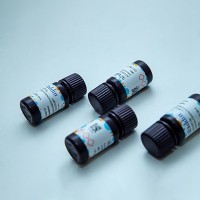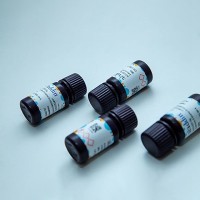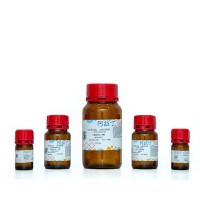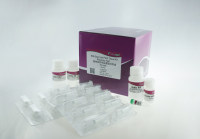利用植物蛋白质芯片研究蛋白磷酸化
丁香园
2755
1. 前言
蛋白质翻译后磷酸化修饰是影响真核细胞每一个细胞内活动过程的最丰富的细胞调节形式。一个蛋白质的磷酸化能引起结构、稳定性、酶活,与其他分子之间相互作用的能力或其亚细胞定位的改变。蛋白激酶催化可逆的蛋白质底物的磷酸化,作用在其丝氨 酸、苏氨酸和酪氨酸残基位点上。如在拟南芥中,丝氨酸/苏氨酸激酶占整个蛋白质组 的 4% [1] ,但对它们的生物学功能还不十分了解。因此,我们需要能开展蛋白激酶全球分析的高通量蛋白质组学方法[ 2,3] 来鉴定下游底物。
用于确定磷酸化共有位点的序列,包括肽库和肽芯片 [5,6] 的多种技术可用来鉴定激酶底物。此外,一种 λ 噬菌体 cDNA 表达文库的固相磷酸化筛选 [ 7,8 」以及不同蛋白质相互作用筛选方法,如覆盖方法 [ 9,11] 和酵母双杂交系统 [ 12,14] 已被应用在这方面。最近,蛋白激酶被改造成可接受人工合成的腺苷三磷酸盐(环戊基 ATP ) 模拟物,并用于鉴定特异底物。初步的研究已经证明,通过激酶来研究磷酸化的蛋白质芯片是可行的 [ 18,19] 。为了确定磷酸化位点,抗磷酸化蛋白表位 [6] 的抗体将用于蛋白质芯片检测。此外,肽芯片或基于质谱的方法[ 20,21] 也可以用于这方面。
我们在此介绍基于蛋白质芯片技术的蛋白磷酸化筛选方法和高通量确定蛋白激酶底物的方法。我们已成功地用这种筛选工具鉴定大麦酪蛋白激酶 2α ( CK 2α) 和不同的拟南芥丝裂原活化蛋白(MAP) 激酶 [23] 的新靶标。我们这个方法使用本书第 28 章详细描述的植物蛋白质芯片(见第 28 章)。在放射性【 γ33 磷】三磷酸腺苷存在的条件下,用可溶和具有活性的激酶孵育芯片。通过磷屏成像仪或 X 射线胶片检测到的放射性信号,对可能的底物进行筛选。我们通过离体印迹磷酸化作用来确认可能的底物。总的来说,我们的方法能筛选植物蛋白激酶用于进一步的分析,随后的体内实验对评估它们的生理作用是必不可少的 [ 13,24,25 ]。
2. 材料
2.1 非变性条件下重组激酶的纯化
( 1 ) 培养细胞的培养基:含 100 μg/ml 氨苄青霉素,15 μg/ml 卡那霉素,2% 葡萄糖的 2YB 或 LB 培养基。
( 2 ) 异丙基 β-D-硫代半乳糖苷(IPTG ) 。
( 3 ) 非变性裂解液:300 mmol/L NaCl,50 mmol/L NaH2PO4,10 mmol/L 咪挫,pH 8.0。
( 4 ) 非变性洗涤液:300 mmol/L NaCl,50 mmol/L NaH2PO4,20 mmol/L 咪挫,pH 8.0。
( 5 ) 非变性洗脱液:300 mmol/L NaCl,50 mmol/L NaH2PO4,250 mmol/L 咪唑,pH 8.0。
( 6 ) 溶菌酶。
( 7 ) 苯甲基磺酰氟(PMSF) 。
( 8 ) 超声匀浆器(Branson Ultrasonic, Danbury, CT)。
( 9 ) NiNTA-琼脂糖(NTA:nickel- nitrilotri-acetic acid,镍-三乙酸基氨,Qiagen)。
( 10 ) 1 ml 聚丙烯柱(Qiagen, Hilden,Germany) 。
( 11 ) Bradford 试剂(Bio- Rad, Munich, Germany) 。
2.2 蛋白质芯片上的激酶检测
( 1 ) TBS + Tween ( TBST ):10 mmol/L Tris-HCl,pH 7.5,150 mmol/L NaCl,0.1% (V/V) Tween-20。
( 2 ) 封闭液:2% 牛血清白蛋白(BSA;Sigma, St. Louis, MO) 溶解在 TBST 中。
( 3 ) [ γ33- P ] ATP,250 μCi/ml ( Amersham Pharmacia Biotech Europe,Freiburg,Germany)。
( 4 ) CK 2α 缓冲液:25 mmol/L Tris-HCl pH 8.5,10 mmol/L MgCl2,1 mmol/L 二硫苏糖醇(DTT) 。
( 5 ) FAST 片基(Whatman Schleicher Schuell, Dassel, Germany) 。
( 6 ) 盖片 ( Carl Roth, Karlsruhe, Germany)。
( 7 ) X 射线暗盒(Hypercassette,Amersham Pharmacia, Freiburg, Germany)。
( 8 ) X 射线胶片(Kodak, Stuttgart, Germany) 。
( 9 ) 成像板(BAS-SR 2025,Fujifilm,Japan) 。
( 10 ) 磷屏显像仪(BAS-Reader-5000,Fujifilm) 。
4. 注释
( 1 ) 我们建议在激酶中加入甘油 [ 终浓度为 20% ( V/V)] 后保存在 -80°C,或将激酶在合适的缓冲液环境中冷冻干燥后保存在 -80°C,使用前,冻干的激酶要先用 ddH2O 溶解。
( 2 ) 在进行基于芯片的激酶实验前,我们建议对激酶制备物进行胶内活性检测实验,或用相应激酶(见注释 3 ) 的已知底物在溶液中对激酶的活性进行检测。如果在文献中未查到激酶的最佳活化条件,那么每种激酶的最优活化条件(如最佳缓冲液条件、激酶的浓度、激酶的孵育时间)要通过实验来确定。

( 3 ) 建议使用一种阳性对照(如该激酶的一个已知底物)。在研究大麦 CK2α 实验中 [22],我们用阳性对照来区别大麦蛋白,它们和不同植物 HMG ( 高迁移率群)的蛋白质具有很高的同源性,这些蛋白质就是众所周知的 CK2α 靶蛋白 [28,29] 。在另一项研究实验中,我们用已知的人工合成 MAP 作为阳性对照,分析研究拟南芥的不同 MAP 激酶 [23] 。
( 4 ) 重组蛋白质除了含有各自的蛋白质的编码序列外,常常还包含由克隆载体所编码的 3' 或 5' 标记物。这些标记物的磷酸化可能会导致假阳性结果,因此在芯片实验之前要将其排除掉。用一些已知的不被认为是相应激酶底物,并且具有相同表达模式(相同标记物)的重组蛋白质,在溶液中进行活性激酶的检测实验可能是一种解决问题的办法。在这个检测实验中,这些所选择的蛋白质应该显示阴性结果。
( 5 ) 我们曾对在表层镀膜的 FAST 片基上(表层被硝化纤维来源的聚合物所覆盖)和环氧树脂片基上固定的变性蛋白质进行磷酸化处理,尽管含组氨酸标记蛋白质在这两个片基表层上可被抗 RGS-His6 的抗体检测到,但我们仅在 FAST 片基上检测到蛋白质磷酸化。在其他研究中,纳米井,BSA-NHS ( BSA-N-羟基丁二酰亚胺)片基或 SAM2 ( 抗生物素蛋白链菌素包被膜)片基在芯片激酶实验中都可以被用作表面镀膜涂层。我们综述了不同的芯片表层在包括磷酸化研究在内的不同芯片应用 [31] 。
( 6 ) 在磷酸化实验中可被区别的个别点的最大点样密度极大地依赖于扫描图像板的磷屏显像仪。为确定点样密度,我们建议使用市售的蛋白激酶(如新英格兰 Biolabs 公司生产的 PKA) 。当使用具有 10 μm 分辨率的扫描仪 (如 BioImager FLA 8000,Fujifilm,Japan),结合 11 X 11 的点样模式(点距:410 μm ) 时,我们可以得到足够的分辨率来分析放射信号。更高的点样模式不适合用于放射性检测,因为密集的点会干扰相邻点的信号,导致相邻蛋白信号强度的错误分析,以及错误的背景校正。
( 7 ) TBST 洗涤芯片是为了去除芯片上的尿素,大家知道尿素会减弱芯片检测中激酶的活性。
( 8 ) 用 X 射线胶片检测放射信号时,将胶片放在用保鲜膜包裹的芯片上,曝光时间根据信号的强弱,可从 30 min 到几天。由于 X 射线胶片变黑仅在一个非常有限的范围内与信号强度成线性或正比关系,因此 X 射线胶片的灵敏度可能会引发一些问题。用磷屏显像仪进行检测时,成像板放置在用保鲜膜包裹的芯片上,然后进行扫描。磷屏显像仪的检测灵敏度比 X 射线胶片的要高 10~100 倍,所以它能够更快地检测到结果,或检测到较弱的信号。此外,与 X 射线胶片相比,磷屏显像系统具有更宽的动态范围,它能在一种曝光强度下同时检测到强和弱的信号,而且信号与强度的线性相关性大于 5 ( 100000 : 1 ),这表明在对放射信号定量分析方面,磷屏显像仪要好于 X 射线胶片。
参考文献
1. Champion, A., Kreis, M., Mockaitis, K., Picaud, A., and Henry, Y. (2004) Arabidopsiskinome: after the casting. Funct. Integr. Genomics4, 163-187.
2. Phizicky, E., Bastiaens, P. I., Zhu, H., Snyder, M., and Fields, S. (2003) Protein analysis on a proteomic scale. Nature 422 , 208-215.
3. Kersten, B., Feilner, T., Angenendt, P., Giavalisco, P., Brenner, W., and Biirkle, L. (2004) Proteomic approaches in plant biology. Curr. Proteomics 1, 131-144.
4. Hutti, J. E., Jarrell, E. T., Chang, J. D., et al. (2004) A rapid method for determining protein kinase phosphorylation specificity. Nat. Methods 1, 27-29.
5. Houseman, B. T., Huh, J. H., Kron, S. J., and Mrksich, M . (2002) Peptide chips for the quantitative evaluation of protein kinase activity. Nat. Biotechnol. 20 , 270-274.
6. Lesaicherre, M . L., Uttamchandani, M., Chen, G. Y., and Yao, S. Q. (2002) Antibody-based fluorescence detection of kinase activity on a peptide array. Bioorg.Med. Chem. Lett. 1 2 , 2085-2088.
7. Fukunaga, R. and Hunter, T. (1997) M N K 1 , a n e w M A P kinase-activated protein kinase, isolated by a novel expression screening method for identifying protein kinase substrates. EMBO J. 16, 1921-1933.
8. Fukunaga, R. and Hunter, T. (2004) Identification of M A P K substrates by expression screening with solid-phase phosphorylation, in Methods in Molecular Biology(Seger, R., ed), H u m a n a Press, Totowa, NJ, pp. 211-236.
9. Zhao, J., Dynlacht, B., Imai, T., Hori, T., and Harlow, E. (1998) Expression of N P A T , a novel substrate of cyclin E - C D K 2 , promotes S-phase entry. Genes. Dev.1 2 , 456-461.
10. Zhao, J., Kennedy, B. K., Lawrence, B. D., et al. (2000) N P A T links cyclin E-Cdk2 to the regulation of replication-dependent histone gene transcription. Genes.Dev. 1 4 , 2283-2297.
11. Gao, G., Bracken, A. P., Burkard, K., et al. (2003) N P A T expression is regulated by E 2 F and is essential for cell cycle progression. Mol. Cell. Biol. 2 3, 2821-2833.
12. Waskiewicz, A. J., Flynn, A., Proud, C. G., and Cooper, J. A. (1997) Mitogen- activated protein kinases activate the serine/threonine kinases M n k l and M n k 2 . EMBO J. 16, 1909-1920.
13. Fujita, H., Fujita, H., Takemura, M., et al. (2003) A n ArabidopsisM A D S - b o x protein, A G L 2 4 , is specifically bound to and phosphorylated by meristematic receptor-like kinase ( M R L K ) . Plant Cell Physiol. 44, 735-742.
14. Anderson, G. H. and Hanson, M . R. (2005) The ArabidopsisMei 2 homologue A M L 1 binds AtRaptorlB, the plant homologue of a major regulator of eukaryotic cell growth. BMC Plant Biol.5, 2.
15. Shah, K., Liu, Y., Deirmengian, C., and Shokat, K. M . (1997) Engineering unnatural nucleotide specificity for Rou s sarcoma virus tyrosine kinase to uniquely label its direct substrates. Proc. Natl. Acad. Sci. USA 94 , 3565-3570.
16. Liu, Y., Shah, K., Yang, F., Witucki, L., and Shokat, K. M . (1998) Engineering Src family protein kinases with unnatural nucleotide specificity. Chem. Biol.5, 91-101.
17. Eblen, S. T., Kumar, N. V., Shah, K., et al. (2003) Identification of novel E R K 2 substrates through use of an engineered kinase and A T P analogs. J . Biol. Chem.278, 14926-14935.
18. MacBeath, G. and Schreiber, S. L. (2000) Printing proteins as microarrays for high-throughput function determination. Science 289 , 1760-1763.
19. Zhu, H., Klemic, J. F., Chang, S., et al. (2000) Analysis of yeast protein kinases using protein chips. Nat. Genet. 26, 283— 289.
20. Glinski, M., Romeis, T., Witte, C. P., Wienkoop, S., and Weckwerth, W . (2003) Stable isotope labeling of phosphopeptides for multiparallel kinase target analysis and identification of phosphorylation sites. Rapid Commun. Mass. Spectrom. 17,1579-1584.
21. Ballif, B. A., Villen, J., Beausoleil, S. A., Schwartz, D., and Gygi, S. P. (2004) Phosphoproteomic analysis of the developing mou s e brain. M o l. C e ll. P r o te o m ic s3, 1093-1101.
22. Kramer, A., Feilner, T., Possling, A., et al. (2004) Identification of barley C K 2 a l p h a targets by using the protein microarray technology. P h y to c h e m is tr y 65,1777-1784.
23. Feilner, T., Hultschig, C., Lee, J., et al. (2005) High throughput identification of potential A r a b id o p s is mitogen-activated protein kinase substrates. M o l. C e ll.P r o te o m ic s 4,1558— 1568.
24. Liu, Y. and Zhang, S. (2004) Phosphorylation of 1-aminocyclopropane-l-carboxylic acid synthase by M P K 6 , a stress-responsive mitogen-activated protein kinase, induces ethylene biosynthesis in A r a b id o p s is . P la n t C e ll 16, 3386-3399.
25. Riera, M., Figueras, M., Lopez, C., Goday, A., and Pages, M . (2004) Protein kinase C K 2 modulates developmental functions of the abscisic acid responsive protein Ra b l 7 from maize. P r o c. N a tl. A c a d . S ci. U SA 101, 9879-9884.
26. Bradford, M . M . (1976) A rapid and sensitive method for the quantitation of microgram quantities of protein utilizing the principle of protein-dye binding. A n a l. B io c h e m .72, 248-254.
27. Usami, S., Banno, H., Ito, Y., Nishihama, R., and Machida, Y. (1995) Cutting activates a 46-kilodalton protein kinase in plants. P ro c. N a tl. A c a d . S ci. U SA 92,8660-8664.
28. Grasser, K. D., Maier, U. G., and Feix, G. (1989) A nuclear casein type II kinase from maize endosperm phosphorylating H M G proteins. B io c h e m . B io p h y s . R es.C o m m u n . 162, 456-463.
29. Stemmer, C., Schwander, A., Bau w , G., Fojan, P., and Grasser, K. D. (2002) Protein kinase C K 2 differentially phosphorylates maize chromosomal high mobility group B ( H M G B ) proteins modulating their stability and D N A interactions. /. B io l. C h em . 277, 1092-1098.
30. Boutell, J. M., Hart, D. J., Godber, B. L., Kozlowski, R. Z., and Blackburn, J. M . (2004) Functional protein microarrays for parallel characterisation of p53 mutants. P r o te o m ic s 4, 1950-1958.
31. Feilner, T., Kreutzberger, J., Niemann, B., et al. (2004) Proteomic studies using microarrays. C u rr. P r o te o m ic s 1, 283-295.
蛋白质翻译后磷酸化修饰是影响真核细胞每一个细胞内活动过程的最丰富的细胞调节形式。一个蛋白质的磷酸化能引起结构、稳定性、酶活,与其他分子之间相互作用的能力或其亚细胞定位的改变。蛋白激酶催化可逆的蛋白质底物的磷酸化,作用在其丝氨 酸、苏氨酸和酪氨酸残基位点上。如在拟南芥中,丝氨酸/苏氨酸激酶占整个蛋白质组 的 4% [1] ,但对它们的生物学功能还不十分了解。因此,我们需要能开展蛋白激酶全球分析的高通量蛋白质组学方法[ 2,3] 来鉴定下游底物。
用于确定磷酸化共有位点的序列,包括肽库和肽芯片 [5,6] 的多种技术可用来鉴定激酶底物。此外,一种 λ 噬菌体 cDNA 表达文库的固相磷酸化筛选 [ 7,8 」以及不同蛋白质相互作用筛选方法,如覆盖方法 [ 9,11] 和酵母双杂交系统 [ 12,14] 已被应用在这方面。最近,蛋白激酶被改造成可接受人工合成的腺苷三磷酸盐(环戊基 ATP ) 模拟物,并用于鉴定特异底物。初步的研究已经证明,通过激酶来研究磷酸化的蛋白质芯片是可行的 [ 18,19] 。为了确定磷酸化位点,抗磷酸化蛋白表位 [6] 的抗体将用于蛋白质芯片检测。此外,肽芯片或基于质谱的方法[ 20,21] 也可以用于这方面。
我们在此介绍基于蛋白质芯片技术的蛋白磷酸化筛选方法和高通量确定蛋白激酶底物的方法。我们已成功地用这种筛选工具鉴定大麦酪蛋白激酶 2α ( CK 2α) 和不同的拟南芥丝裂原活化蛋白(MAP) 激酶 [23] 的新靶标。我们这个方法使用本书第 28 章详细描述的植物蛋白质芯片(见第 28 章)。在放射性【 γ33 磷】三磷酸腺苷存在的条件下,用可溶和具有活性的激酶孵育芯片。通过磷屏成像仪或 X 射线胶片检测到的放射性信号,对可能的底物进行筛选。我们通过离体印迹磷酸化作用来确认可能的底物。总的来说,我们的方法能筛选植物蛋白激酶用于进一步的分析,随后的体内实验对评估它们的生理作用是必不可少的 [ 13,24,25 ]。
2. 材料
2.1 非变性条件下重组激酶的纯化
( 1 ) 培养细胞的培养基:含 100 μg/ml 氨苄青霉素,15 μg/ml 卡那霉素,2% 葡萄糖的 2YB 或 LB 培养基。
( 2 ) 异丙基 β-D-硫代半乳糖苷(IPTG ) 。
( 3 ) 非变性裂解液:300 mmol/L NaCl,50 mmol/L NaH2PO4,10 mmol/L 咪挫,pH 8.0。
( 4 ) 非变性洗涤液:300 mmol/L NaCl,50 mmol/L NaH2PO4,20 mmol/L 咪挫,pH 8.0。
( 5 ) 非变性洗脱液:300 mmol/L NaCl,50 mmol/L NaH2PO4,250 mmol/L 咪唑,pH 8.0。
( 6 ) 溶菌酶。
( 7 ) 苯甲基磺酰氟(PMSF) 。
( 8 ) 超声匀浆器(Branson Ultrasonic, Danbury, CT)。
( 9 ) NiNTA-琼脂糖(NTA:nickel- nitrilotri-acetic acid,镍-三乙酸基氨,Qiagen)。
( 10 ) 1 ml 聚丙烯柱(Qiagen, Hilden,Germany) 。
( 11 ) Bradford 试剂(Bio- Rad, Munich, Germany) 。
2.2 蛋白质芯片上的激酶检测
( 1 ) TBS + Tween ( TBST ):10 mmol/L Tris-HCl,pH 7.5,150 mmol/L NaCl,0.1% (V/V) Tween-20。
( 2 ) 封闭液:2% 牛血清白蛋白(BSA;Sigma, St. Louis, MO) 溶解在 TBST 中。
( 3 ) [ γ33- P ] ATP,250 μCi/ml ( Amersham Pharmacia Biotech Europe,Freiburg,Germany)。
( 4 ) CK 2α 缓冲液:25 mmol/L Tris-HCl pH 8.5,10 mmol/L MgCl2,1 mmol/L 二硫苏糖醇(DTT) 。
( 5 ) FAST 片基(Whatman Schleicher Schuell, Dassel, Germany) 。
( 6 ) 盖片 ( Carl Roth, Karlsruhe, Germany)。
( 7 ) X 射线暗盒(Hypercassette,Amersham Pharmacia, Freiburg, Germany)。
( 8 ) X 射线胶片(Kodak, Stuttgart, Germany) 。
( 9 ) 成像板(BAS-SR 2025,Fujifilm,Japan) 。
( 10 ) 磷屏显像仪(BAS-Reader-5000,Fujifilm) 。
4. 注释
( 1 ) 我们建议在激酶中加入甘油 [ 终浓度为 20% ( V/V)] 后保存在 -80°C,或将激酶在合适的缓冲液环境中冷冻干燥后保存在 -80°C,使用前,冻干的激酶要先用 ddH2O 溶解。
( 2 ) 在进行基于芯片的激酶实验前,我们建议对激酶制备物进行胶内活性检测实验,或用相应激酶(见注释 3 ) 的已知底物在溶液中对激酶的活性进行检测。如果在文献中未查到激酶的最佳活化条件,那么每种激酶的最优活化条件(如最佳缓冲液条件、激酶的浓度、激酶的孵育时间)要通过实验来确定。

( 3 ) 建议使用一种阳性对照(如该激酶的一个已知底物)。在研究大麦 CK2α 实验中 [22],我们用阳性对照来区别大麦蛋白,它们和不同植物 HMG ( 高迁移率群)的蛋白质具有很高的同源性,这些蛋白质就是众所周知的 CK2α 靶蛋白 [28,29] 。在另一项研究实验中,我们用已知的人工合成 MAP 作为阳性对照,分析研究拟南芥的不同 MAP 激酶 [23] 。
( 4 ) 重组蛋白质除了含有各自的蛋白质的编码序列外,常常还包含由克隆载体所编码的 3' 或 5' 标记物。这些标记物的磷酸化可能会导致假阳性结果,因此在芯片实验之前要将其排除掉。用一些已知的不被认为是相应激酶底物,并且具有相同表达模式(相同标记物)的重组蛋白质,在溶液中进行活性激酶的检测实验可能是一种解决问题的办法。在这个检测实验中,这些所选择的蛋白质应该显示阴性结果。
( 5 ) 我们曾对在表层镀膜的 FAST 片基上(表层被硝化纤维来源的聚合物所覆盖)和环氧树脂片基上固定的变性蛋白质进行磷酸化处理,尽管含组氨酸标记蛋白质在这两个片基表层上可被抗 RGS-His6 的抗体检测到,但我们仅在 FAST 片基上检测到蛋白质磷酸化。在其他研究中,纳米井,BSA-NHS ( BSA-N-羟基丁二酰亚胺)片基或 SAM2 ( 抗生物素蛋白链菌素包被膜)片基在芯片激酶实验中都可以被用作表面镀膜涂层。我们综述了不同的芯片表层在包括磷酸化研究在内的不同芯片应用 [31] 。
( 6 ) 在磷酸化实验中可被区别的个别点的最大点样密度极大地依赖于扫描图像板的磷屏显像仪。为确定点样密度,我们建议使用市售的蛋白激酶(如新英格兰 Biolabs 公司生产的 PKA) 。当使用具有 10 μm 分辨率的扫描仪 (如 BioImager FLA 8000,Fujifilm,Japan),结合 11 X 11 的点样模式(点距:410 μm ) 时,我们可以得到足够的分辨率来分析放射信号。更高的点样模式不适合用于放射性检测,因为密集的点会干扰相邻点的信号,导致相邻蛋白信号强度的错误分析,以及错误的背景校正。
( 7 ) TBST 洗涤芯片是为了去除芯片上的尿素,大家知道尿素会减弱芯片检测中激酶的活性。
( 8 ) 用 X 射线胶片检测放射信号时,将胶片放在用保鲜膜包裹的芯片上,曝光时间根据信号的强弱,可从 30 min 到几天。由于 X 射线胶片变黑仅在一个非常有限的范围内与信号强度成线性或正比关系,因此 X 射线胶片的灵敏度可能会引发一些问题。用磷屏显像仪进行检测时,成像板放置在用保鲜膜包裹的芯片上,然后进行扫描。磷屏显像仪的检测灵敏度比 X 射线胶片的要高 10~100 倍,所以它能够更快地检测到结果,或检测到较弱的信号。此外,与 X 射线胶片相比,磷屏显像系统具有更宽的动态范围,它能在一种曝光强度下同时检测到强和弱的信号,而且信号与强度的线性相关性大于 5 ( 100000 : 1 ),这表明在对放射信号定量分析方面,磷屏显像仪要好于 X 射线胶片。
参考文献
1. Champion, A., Kreis, M., Mockaitis, K., Picaud, A., and Henry, Y. (2004) Arabidopsiskinome: after the casting. Funct. Integr. Genomics4, 163-187.
2. Phizicky, E., Bastiaens, P. I., Zhu, H., Snyder, M., and Fields, S. (2003) Protein analysis on a proteomic scale. Nature 422 , 208-215.
3. Kersten, B., Feilner, T., Angenendt, P., Giavalisco, P., Brenner, W., and Biirkle, L. (2004) Proteomic approaches in plant biology. Curr. Proteomics 1, 131-144.
4. Hutti, J. E., Jarrell, E. T., Chang, J. D., et al. (2004) A rapid method for determining protein kinase phosphorylation specificity. Nat. Methods 1, 27-29.
5. Houseman, B. T., Huh, J. H., Kron, S. J., and Mrksich, M . (2002) Peptide chips for the quantitative evaluation of protein kinase activity. Nat. Biotechnol. 20 , 270-274.
6. Lesaicherre, M . L., Uttamchandani, M., Chen, G. Y., and Yao, S. Q. (2002) Antibody-based fluorescence detection of kinase activity on a peptide array. Bioorg.Med. Chem. Lett. 1 2 , 2085-2088.
7. Fukunaga, R. and Hunter, T. (1997) M N K 1 , a n e w M A P kinase-activated protein kinase, isolated by a novel expression screening method for identifying protein kinase substrates. EMBO J. 16, 1921-1933.
8. Fukunaga, R. and Hunter, T. (2004) Identification of M A P K substrates by expression screening with solid-phase phosphorylation, in Methods in Molecular Biology(Seger, R., ed), H u m a n a Press, Totowa, NJ, pp. 211-236.
9. Zhao, J., Dynlacht, B., Imai, T., Hori, T., and Harlow, E. (1998) Expression of N P A T , a novel substrate of cyclin E - C D K 2 , promotes S-phase entry. Genes. Dev.1 2 , 456-461.
10. Zhao, J., Kennedy, B. K., Lawrence, B. D., et al. (2000) N P A T links cyclin E-Cdk2 to the regulation of replication-dependent histone gene transcription. Genes.Dev. 1 4 , 2283-2297.
11. Gao, G., Bracken, A. P., Burkard, K., et al. (2003) N P A T expression is regulated by E 2 F and is essential for cell cycle progression. Mol. Cell. Biol. 2 3, 2821-2833.
12. Waskiewicz, A. J., Flynn, A., Proud, C. G., and Cooper, J. A. (1997) Mitogen- activated protein kinases activate the serine/threonine kinases M n k l and M n k 2 . EMBO J. 16, 1909-1920.
13. Fujita, H., Fujita, H., Takemura, M., et al. (2003) A n ArabidopsisM A D S - b o x protein, A G L 2 4 , is specifically bound to and phosphorylated by meristematic receptor-like kinase ( M R L K ) . Plant Cell Physiol. 44, 735-742.
14. Anderson, G. H. and Hanson, M . R. (2005) The ArabidopsisMei 2 homologue A M L 1 binds AtRaptorlB, the plant homologue of a major regulator of eukaryotic cell growth. BMC Plant Biol.5, 2.
15. Shah, K., Liu, Y., Deirmengian, C., and Shokat, K. M . (1997) Engineering unnatural nucleotide specificity for Rou s sarcoma virus tyrosine kinase to uniquely label its direct substrates. Proc. Natl. Acad. Sci. USA 94 , 3565-3570.
16. Liu, Y., Shah, K., Yang, F., Witucki, L., and Shokat, K. M . (1998) Engineering Src family protein kinases with unnatural nucleotide specificity. Chem. Biol.5, 91-101.
17. Eblen, S. T., Kumar, N. V., Shah, K., et al. (2003) Identification of novel E R K 2 substrates through use of an engineered kinase and A T P analogs. J . Biol. Chem.278, 14926-14935.
18. MacBeath, G. and Schreiber, S. L. (2000) Printing proteins as microarrays for high-throughput function determination. Science 289 , 1760-1763.
19. Zhu, H., Klemic, J. F., Chang, S., et al. (2000) Analysis of yeast protein kinases using protein chips. Nat. Genet. 26, 283— 289.
20. Glinski, M., Romeis, T., Witte, C. P., Wienkoop, S., and Weckwerth, W . (2003) Stable isotope labeling of phosphopeptides for multiparallel kinase target analysis and identification of phosphorylation sites. Rapid Commun. Mass. Spectrom. 17,1579-1584.
21. Ballif, B. A., Villen, J., Beausoleil, S. A., Schwartz, D., and Gygi, S. P. (2004) Phosphoproteomic analysis of the developing mou s e brain. M o l. C e ll. P r o te o m ic s3, 1093-1101.
22. Kramer, A., Feilner, T., Possling, A., et al. (2004) Identification of barley C K 2 a l p h a targets by using the protein microarray technology. P h y to c h e m is tr y 65,1777-1784.
23. Feilner, T., Hultschig, C., Lee, J., et al. (2005) High throughput identification of potential A r a b id o p s is mitogen-activated protein kinase substrates. M o l. C e ll.P r o te o m ic s 4,1558— 1568.
24. Liu, Y. and Zhang, S. (2004) Phosphorylation of 1-aminocyclopropane-l-carboxylic acid synthase by M P K 6 , a stress-responsive mitogen-activated protein kinase, induces ethylene biosynthesis in A r a b id o p s is . P la n t C e ll 16, 3386-3399.
25. Riera, M., Figueras, M., Lopez, C., Goday, A., and Pages, M . (2004) Protein kinase C K 2 modulates developmental functions of the abscisic acid responsive protein Ra b l 7 from maize. P r o c. N a tl. A c a d . S ci. U SA 101, 9879-9884.
26. Bradford, M . M . (1976) A rapid and sensitive method for the quantitation of microgram quantities of protein utilizing the principle of protein-dye binding. A n a l. B io c h e m .72, 248-254.
27. Usami, S., Banno, H., Ito, Y., Nishihama, R., and Machida, Y. (1995) Cutting activates a 46-kilodalton protein kinase in plants. P ro c. N a tl. A c a d . S ci. U SA 92,8660-8664.
28. Grasser, K. D., Maier, U. G., and Feix, G. (1989) A nuclear casein type II kinase from maize endosperm phosphorylating H M G proteins. B io c h e m . B io p h y s . R es.C o m m u n . 162, 456-463.
29. Stemmer, C., Schwander, A., Bau w , G., Fojan, P., and Grasser, K. D. (2002) Protein kinase C K 2 differentially phosphorylates maize chromosomal high mobility group B ( H M G B ) proteins modulating their stability and D N A interactions. /. B io l. C h em . 277, 1092-1098.
30. Boutell, J. M., Hart, D. J., Godber, B. L., Kozlowski, R. Z., and Blackburn, J. M . (2004) Functional protein microarrays for parallel characterisation of p53 mutants. P r o te o m ic s 4, 1950-1958.
31. Feilner, T., Kreutzberger, J., Niemann, B., et al. (2004) Proteomic studies using microarrays. C u rr. P r o te o m ic s 1, 283-295.







